TOO MUCH TRAGEDY SPOILS CLEVER CONCEIT
Prior to curtain at Sacred Fools’ production of Stoneface, the packed house watched samplings of Buster Keaton’s films, projected on a screen center stage. Hushed and rapt, almost reverent, many were even leaning forward towards the screen. When a funny bit occurred, the audience roared in unison, then just as quickly returned to awed worship. When a gentleman behind me began to talk to his friend, a patron in front of me turned around and sneered at the man (and, mind you, this was before the show started). I must admit, his voice was jarring and almost offensive given the black-and-white genius before us. Indeed, Keaton’s cinematic mastery, responsible for some of the greatest moments ever captured on film, is more than worthy of such adoration.
The real-life, washed-up Keaton in Vanessa Claire Stewart’s world premiere play, however, hardly evokes veneration. The tragicomedy Stoneface may be subtitled The Rise and Fall and Rise of Buster Keaton, but the script’s dirty-laundry subject matter is so depressing that a more apt subtitle would be The Fall and Fall and Fall (and some Pratfalls and a quick Rise) of Buster Keaton. There are insightful bits and pieces elucidating how Keaton came to be such a skilled filmmaker, but as constructed, the play can best be described as a travelogue of stereopticon slides of the brilliant star’s life, with scenes presented in a variety of formats – some of them straightforward, but most in the style of silent film, both projected and live. While we are treated to the ever-inventive direction of Jamie Robledo, a sparkling cast, and a crackerjack multi-media and technical team, the play never gains momentum, running like a sputtering jalopy on a joy ride, diverting yet discomfiting.
Stoneface also showcases the comedic chops and physical expertise of French Stewart, who masterfully brings the sad-clown soul of Keaton to life (the rubbery and expressive Joe Fria is the younger Keaton). But the script feels like a skeletal outline for a musical drama, assembled like a Penny Arcade “mutoscope” (where you can look into a single-lens hood to see a “flip-book” version of moving pictures). 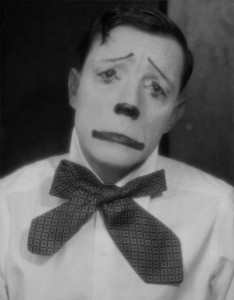 Except for a very touching epilogue (largely due to Mr. Stewart’s glorious vulnerability), the material (which highlights alcoholism, failed marriages, and a broken career) is so disheartening and disjointed (ten years or more pass with no explanation), that the amazingly-staged piece ultimately suffers from identity crisis.
Except for a very touching epilogue (largely due to Mr. Stewart’s glorious vulnerability), the material (which highlights alcoholism, failed marriages, and a broken career) is so disheartening and disjointed (ten years or more pass with no explanation), that the amazingly-staged piece ultimately suffers from identity crisis.
The prologue is a short, mock silent film displaying Keaton as a youth performing with his family in Vaudeville. Dad tells his son – via projected placards – that he would get more laughs with a deadpan reaction. We see the boy’s amazing aptitude for knockabout comedy without getting injured, and learn that dad referred to his son Joseph Frank Keaton as “buster,” taken from the term used to describe a fall that had the potential to cause bodily harm. The last image we see is a happy-go-lucky family trio, but the fascinating background, although inventively told, immediately feels like a downer since dad is depicted as a child abuser.
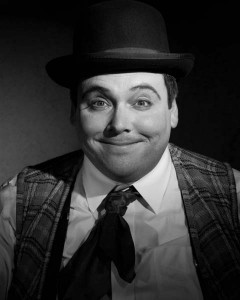 Then the script jumps from the aughts to circa 1920, and we meet the characters who will play prominently in Keaton’s life: Roscoe “Fatty” Arbuckle (Scott Leggett, a comic virtuoso), who gave Keaton his break into the movies and will become his lifelong friend; producer Joseph Schenk (Jake Broder), who is married to actress Norma Talmadge (Rena Strober); and her sister Natalie (a lithe Tegan Ashton Cohen), with whom Keaton has a disastrous marriage which produces two estranged sons. The device that introduces these characters is an enormous audience-pleaser: the live-action actors emerge from the back of the house, photographer’s flashbulbs go off, and the actors disappear behind a screen, only to reemerge on film. It is a maneuver seen before on stage (Kneehigh’s Brief Encounter at A.C.T.), but it remains positively exhilarating (video/projection design by Ben Rock & Anthony Brackman, special effects by James McCartney).
Then the script jumps from the aughts to circa 1920, and we meet the characters who will play prominently in Keaton’s life: Roscoe “Fatty” Arbuckle (Scott Leggett, a comic virtuoso), who gave Keaton his break into the movies and will become his lifelong friend; producer Joseph Schenk (Jake Broder), who is married to actress Norma Talmadge (Rena Strober); and her sister Natalie (a lithe Tegan Ashton Cohen), with whom Keaton has a disastrous marriage which produces two estranged sons. The device that introduces these characters is an enormous audience-pleaser: the live-action actors emerge from the back of the house, photographer’s flashbulbs go off, and the actors disappear behind a screen, only to reemerge on film. It is a maneuver seen before on stage (Kneehigh’s Brief Encounter at A.C.T.), but it remains positively exhilarating (video/projection design by Ben Rock & Anthony Brackman, special effects by James McCartney).
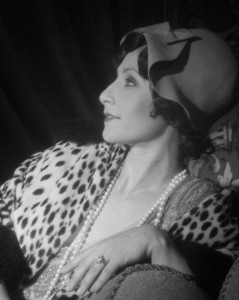 Two sources of bemusement then occur:
Two sources of bemusement then occur:
First, the young Keaton (Mr. Fria) appears, looking as he did at the height of his fame, but when the flashbulbs go off, he has a decidedly disappointed look on his face. Does he hate his life? His work? The attention?
Second, we are suddenly and confusingly thrust another decade forward where the elder, disordered, disgusted Keaton (Mr. Stewart) sits straightjacketed in a hospital bed. A placard reads: “1933. AFTER ENDLESS DRINKING BINGES, MGM FIGUREHEAD LOUIS B MAYER SENT A DOWN-AND-OUT BUSTER TO ARROWHEAD SPRINGS DRY-OUT CLINIC.”
Wait. What’s he doing at MGM? Alcoholic? This is the rise of Buster Keaton?
A nurse attends to Keaton while he sits mute. After she drolly prattles on, it comes to light that this is Mae Scriven (a delightful Erin Parks), Keaton’s second wife, whom he married during an extended alcoholic binge (they would be divorced 2 years later for Keaton’s infidelity). Finally, Mae delivers a line to the muddled actor, “You were blacked out for a long time, darling. But you have to at least remember Mexico!” But then the next scene is not Mexico, but a flashback to the backstage of a 1917 Hollywood studio where Arbuckle, in the mode of a silent film, is educating the young Keaton. The use of a cardboard car and a stagehand dusting fake snow on the actors is terrific (set design by Joel Daavid, assisted by DeAnne Millais).
Very soon, we’re back at the 1933 drunk tank. Wait. No, we’re not. The scene is now in the style of a 1918 silent movie Good Night, Nurse. Mae is a crazy patient, Buster a doting husband, and Arbuckle is in drag as a nurse. Are the three reenacting an actual silent film or Keaton’s marriage to Mae? The shenanigans on stage are so clever and entertaining that this would be a good point to give up on the non-linear storytelling and just enjoy the ride.
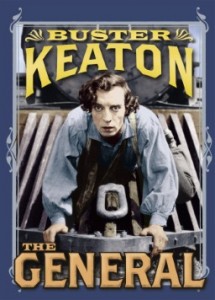 But it’s tough to do that when we are bestowed almost non-stop bad news about a man that the world admires. After Good Night, Nurse, in fact, we return again to the 1933 dry-out clinic, where Buster admits that he’s a blacked-out drunk well on his way to death and departs from Mae. If Buster Keaton is such a hero on screen and behind-the-camera, why is he consistently depicted as such a loser in life?
But it’s tough to do that when we are bestowed almost non-stop bad news about a man that the world admires. After Good Night, Nurse, in fact, we return again to the 1933 dry-out clinic, where Buster admits that he’s a blacked-out drunk well on his way to death and departs from Mae. If Buster Keaton is such a hero on screen and behind-the-camera, why is he consistently depicted as such a loser in life?
On it goes: more alcoholism; penury and the loss of his gorgeous Italian-style villa (where two-reelers are left in the basement to rot); debasement at the hands of Louis B. Mayer (Pat Towne), who Keaton repeatedly calls “asshole” while drunk; lousy reviews for the expensive misfire The General (now regarded as one of the finest films ever made); forced into a loveless marriage to Talmadge, who takes all of Keaton’s possessions, including his sons, in a divorce; a humiliated Keaton too drunk to work with director Edward Sedgwick (Connor Duffy) on a talkie; blackballed by Hollywood; fired by MGM; filming lousy movies in Mexico to pay his bills – and we ain’t even out of the first act yet.
I can’t tell you how much I appreciate the hard-working actors and the many, many people behind the scene who brought this play, however discouraging, to life. Among the notables are Jessica Olson’s authentic costumes, Jeremy Pivnick’s extraordinary lighting, Andrew Amani’s stunt choreography, and Ryan Johnson’s remarkably expressive piano accompaniment. Some of the scenes, in and of themselves, are brilliantly funny and entertaining: At the top of Act II, Mr. Stewart and Mr. Leggett rue the state of Hollywood as they brilliantly execute a comic bit with a rack of stringed utensils; it’s a dazzling morsel of stagecraft.
In the end, the production inspired even as the story of Stoneface did not.
* * * * * * * * * * * * * * * * * * * * * * * * *
photos by Shaela Cook
Stoneface: The Rise and Fall and Rise of Buster Keaton
Sacred Fools Theater
660 N. Heliotrope Drive in Hollywood
Fri and Sat at 8; Sun at 2
ends on June 30 EXTENDED through August 26, 2012
for tickets, call 310-281-8337 or visit Sacred Fools
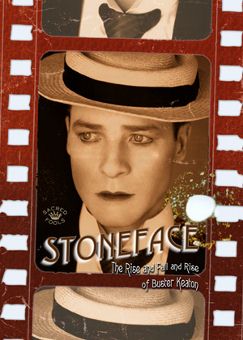
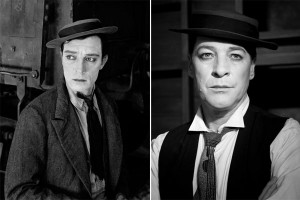
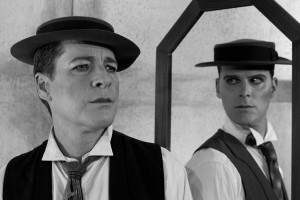
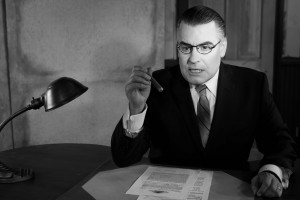

{ 4 comments… read them below or add one }
I totally disagree with this review. I thought the show was brilliant and the audience I saw it with seemed to agree by the laughter, reverence and standing ovation. This is LA Theatre at it’s best!
I agree totally with the very perceptive and detailed review. After the first act, I said to my husband, “This is a downer!” It was very depressing and disjointed. Athough alcoholism dominated his life, did we really need to observe so much of it? However, the second act redeemed the play.
I also agree with the reviewer about the quality of the production: excellent acting, staging, directon, music, etc. Ultimately I recommend this play.
This review hit the nail on the head – the direction, performances, and design were all excellent. The script, however, is messy, over-long and very confusing. At no point do we identify with Buster Keaton despite French Stewart’s bravura performance.
I totally agree. The script was a mess. It’s too bad, I was really looking forward to this show. I did not laugh once. The actors did their best with what they were given, but the story failed them.